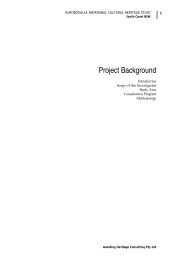Eurobodalla Integrated Water Cycle Management Strategy
Eurobodalla Integrated Water Cycle Management Strategy
Eurobodalla Integrated Water Cycle Management Strategy
You also want an ePaper? Increase the reach of your titles
YUMPU automatically turns print PDFs into web optimized ePapers that Google loves.
<strong>Eurobodalla</strong> <strong>Integrated</strong> <strong>Water</strong> <strong>Cycle</strong> <strong>Management</strong> <strong>Strategy</strong><br />
68 ML/a of urban stormwater is discharged to the environment, consisting of approximately<br />
64 500 kg/a of total nitrogen and 8 500 kg/a of phosphorus (based on median year rainfall).<br />
Testing of urban stormwater from other coastal towns and villages suggests that urban<br />
stormwater also contains significant loads of sediment, litter, bacteria and other pathogenic<br />
organisms. At present there is limited urban stormwater quality control and management,<br />
and no beneficial reuse of stormwater. Continual urban development without considering<br />
appropriate stormwater management options will result in the continual decline of<br />
environmental water quality and represent an increased risk to public health. The<br />
stormwater issues relating to each individual town and village are discussed in more detail<br />
in part C.<br />
6.4.2 Urban <strong>Water</strong> Use and Discharge – Future Predictions<br />
Urban <strong>Water</strong> Use<br />
The population of the <strong>Eurobodalla</strong> Shire is expected to increase by 50% over the next three<br />
decades, with most of this increase being accommodated within the major coastal urban<br />
centres, as either new subdivision or as infill development within existing residential areas.<br />
This increase in population will correlate to a growing demand for water, and consequently<br />
increase wastewater and urban stormwater volumes.<br />
The future urban water demands have been projected using three approaches as follows:<br />
Traditional approach<br />
Contemporary approach<br />
Demand Managed approach (see section 8.1 for details)<br />
Traditional Approach – In this approach the water demands are projected by modelling<br />
the individual end uses for a typical property and then extrapolating this per property<br />
demand to the whole community. The model is then calibrated against actual metered<br />
quarterly consumption by estimating the residential indoor demand and the seasonal<br />
demand variations. Thus the only factor that is considered to affect demand is population<br />
growth. Macoun (1999) used this approach to forecast the demands. The population<br />
forecast used was based on the low population increase predicted by DUAP.<br />
Contemporary Approach – In predicting the water demands using this approach,<br />
consideration is given to the mandatory plumbing regulation governing the toilet cisterns<br />
and the future availability of plumbing fixtures and devices, and household white goods.<br />
Consideration is also given to Council’s current water conservation initiatives along with the<br />
past climatic and economic influences on demands. The population growth rate used in<br />
this approach incorporated the 2001 census and was lower than that used in the traditional<br />
approach as discussed earlier. The demand projected using this approach is referred to as<br />
‘baseline’ in Figure 6-12.<br />
Figure 6-12. shows the predicted annual water demands until year 2032.<br />
47

















